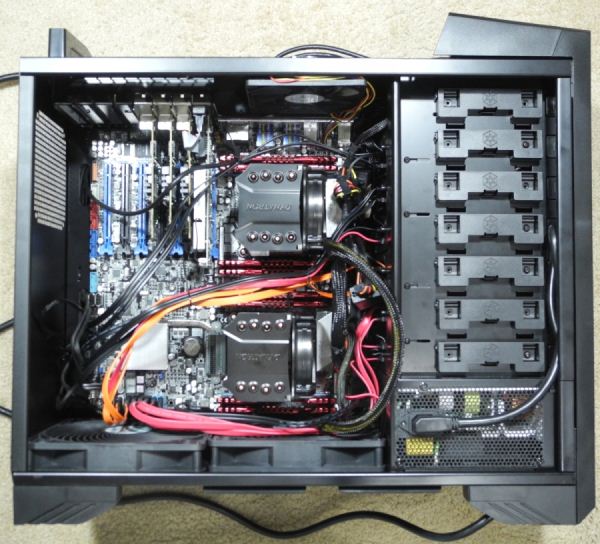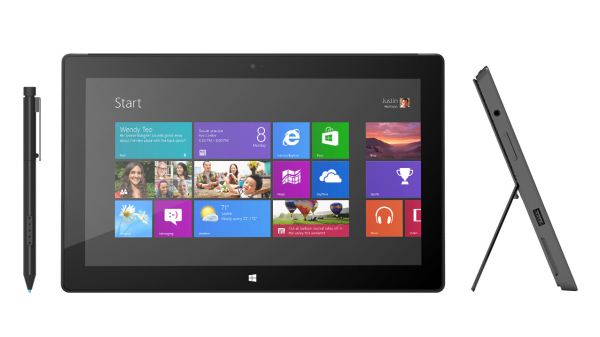AnandTech Article Channel |
- The AnandTech Podcast: Episode 11
- Updating the 2012 AnandTech SMB / SOHO NAS Testbed
- Microsoft Announces Surface Pro Pricing and Availability: 17W IVB Starting at $899 in January 2013
| The AnandTech Podcast: Episode 11 Posted: 29 Nov 2012 07:21 PM PST We're back! Brian and I recorded this one just after the holidays last week. Despite there not being a lot going on release wise, we had a bunch to talk about. Brian gave us updates on his experience with the Lumia 920, Droid DNA and Samsung's Galaxy Camera. I talk a bit about what the future holds for driving smartphone costs down, and we both talked about Nintendo's Wii U.
The AnandTech Podcast - Episode 11 iTunes Total Time: 1 hour 48 minutes Outline - hh:mm Nokia Lumia 920 - 00:00 Wireless Charging - 00:08 The Lumia 920 vs. Windows Phone 8X - 00:10 Verizon's Droid DNA - 00:21 Driving Smartphone Costs Down - 00:31 Paul Otellini's Early Retirement - 00:44 Samsung Galaxy Camera - 00:53 Google Nexus 4 LTE - 01:09 Inside the Nintendo Wii U - 01:20 Black Magic Intensity Pro - 01:33 Apple iPad 4 - 01:35 As always, comments are welcome and appreciated. | |||||||||||||||||||||||||||||||||||||||||||||||||
| Updating the 2012 AnandTech SMB / SOHO NAS Testbed Posted: 29 Nov 2012 11:00 AM PST In early September, we published a piece detailing our SMB / SOHO NAS testbed. Subsequently, we received extensive feedback from readers regarding the testbed as well as the proposed testing methodology. The universal consensus was that the VM (virtual machine) density could be increased (given the dual Xeon processors and the minimal load on the CPU from the workload). Readers also helpfully pointed out traces that could potentially replicate NAS (Network Attached Storage) usage in typical home scenarios. We set out to implement the suggestions within the constraints of the existing workstation. Between the set up of the original testbed and the beginning of the update process, NAS vendors also started offering rackmount units with 10 GbE capability. Netgear graciously accepted our request to participate in our upgrade process by providing us with a 10 GbE capable switch. Read on to find out the how we went about updating the testbed and some results from putting the Thecus N4800 under the scanner with the new environment. | |||||||||||||||||||||||||||||||||||||||||||||||||
| Microsoft Announces Surface Pro Pricing and Availability: 17W IVB Starting at $899 in January 2013 Posted: 29 Nov 2012 10:15 AM PST Last month I reviewed Microsoft's Surface RT tablet, and came away generally impressed. The form factor and attention to detail were both much better than expected from Microsoft. The integration of the touch/type covers into the design was very well executed in my opinion. That being said, Surface RT seemed to me like a great start but not the perfect product. I would love to see a Cortex A15 based version with some minor tweaks. We'll likely get that next year, but before then there's one more Surface tablet that we'll meet: the Surface Pro. Surface RT is Microsoft's Windows RT (Windows on ARM) launch vehicle, while Surface Pro is based on Intel x86 hardware. Despite the funny wording in today's blog post, Surface Pro uses an Ivy Bridge based Core i5 (ULV) processor with Intel HD 4000 graphics. Contrary to what I assumed initially, Surface Pro will launch with a 17W Ivy Bridge CPU - so this is the same chip you'll find in modern Ultrabooks. Without a doubt we'll see a Haswell version sometime next year, but not at launch. I wondered if we might see Microsoft use Intel's upcoming 10W Ivy Bridge, but at this point that seems unlikely. Surface Pro keeps the same display size, but increases tablet thickness by 43% over the RT version. Weight is also up by half a pound. Screen resolution goes up as well, at 1920 x 1080. Memory capacity also increases to 4GB, and Surface Pro comes with much more NAND on-board. With a 7-series chipset you get SATA support, so my money is on Surface Pro having a full blown SSD inside instead of something eMMC based.
Battery capacity goes up to 42Wh, an increase of 33%, putting it about on par with the 3rd and 4th generation iPads. Charger size also goes up to 48W compared to 24W with the RT version. Update: Microsoft announced via its Surface Twitter account that the Pro version would offer roughly half the battery life of Surface RT. Without S0ix support, Surface Pro should look a lot like a standard Ultrabook when it comes to battery life. If you want the best of both worlds, Haswell will be what you'll need to wait for. The big news is we now have pricing for Surface Pro: $899 for the 64GB model and $999 for the 128GB model, both available in January 2013. Both versions come with a Surface pen, but neither includes a touch or type cover. Microsoft's Surface Pro pricing is clearly higher than any other ARM based tablet, but I'd look at it more as an Ultrabook/MacBook Air alternative. I'll reserve final judgement for when I get my hands on a review sample, but I'm pretty interested to see how the Pro does in our tests. This could end up being one of the better Ultrabooks. I do wish Microsoft had thrown in a touch or type cover into the bundle though, that would make it a real alternative to a standard Ultrabook without having to pay for anything else. It is entirely possible that Microsoft is banking on notebook users bringing a more traditional keyboard and mouse for work though. The other big omission is the lack of Thunderbolt support. I don't know what it is with Microsoft's crusade against Thunderbolt (the port is no longer on Acer's W700 either), but I think that's a big mistake. Surface Pro would be a great platform for Thunderbolt in my opinion. For full specs check out the Surface Pro on Microsoft's site. | |||||||||||||||||||||||||||||||||||||||||||||||||
| You are subscribed to email updates from AnandTech To stop receiving these emails, you may unsubscribe now. | Email delivery powered by Google |
| Google Inc., 20 West Kinzie, Chicago IL USA 60610 | |






No comments:
Post a Comment